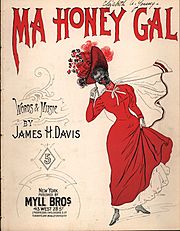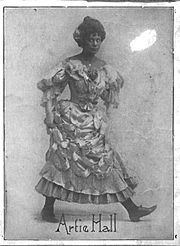Coon song facts for kids
Quick facts for kids Coon song |
|
|---|---|
| Stylistic origins | |
| Cultural origins | c. 1840s United States |
| Other topics | |
Coon songs were a type of music popular in the United States and Australia from about 1880 to 1920. These songs often showed harmful and untrue ideas about African Americans. They came from earlier minstrel shows, which started around 1848. Both white and black performers sang these songs, sometimes wearing blackface makeup. This makeup was used to make fun of black people. Women singers, called 'coon shouters,' also became famous in this music style.
Contents
The Rise and Fall of Coon Songs
The song "Zip Coon" became popular in the 1830s. George Washington Dixon often performed it in blackface. The word "coon" was already used as a hurtful term for black people.
The first song clearly called a "coon song" was "The Dandy Coon's Parade" in 1880. Other early songs included "New Coon in Town" (1883) and "Coon Salvation Army" (1884).
By the mid-1880s, coon songs were very popular across the country. Over 600 such songs were published in the 1890s. The most successful songs sold millions of copies. To keep up with this trend, composers added "coon song" words to older songs.
The first hit song recorded by a black man was "The Whistling Coon" by George W. Johnson.
After 1900, people started to criticize coon songs. They were seen as racist. In 1905, Bob Cole, an African-American composer, spoke out. He said the time for such songs had passed.
In 1908, a short film called "Coon Song" was released. It featured famous singers. After more criticism, the use of "coon" in song titles dropped a lot after 1910.
On August 13, 1920, Marcus Garvey's group, the Universal Negro Improvement Association and African Communities League, created the Pan-African flag. This flag was a direct response to the song "Every Race Has a Flag but the Coon". This song, along with "Coon, Coon, Coon" and "All Coons Look Alike to Me", helped make the term "coon" a common slur in America.
The word "coon" was first linked to the Whig Party in the 1830s. The Whigs used a raccoon as their symbol. They also seemed more accepting of black people than other groups. This might be why the term changed from political slang to a racial slur.
Some historians think coon songs became popular because the music business was growing fast. Others believe these songs helped justify unfair treatment of black people. They made it seem okay to keep black people separate and unequal. The songs often showed black people as a threat to society. This suggested they needed to be controlled.
Composers of Coon Songs
When coon songs were most popular, many songwriters created them. This was because there was a huge demand. Important composers from Tin Pan Alley wrote coon songs. These included Gus Edwards and Irving Berlin. Fred Fisher wrote "If the Man in the Moon Were a Coon" in 1905, which sold three million copies. Even Arthur Pryor, who worked with John Philip Sousa, composed coon songs. This helped make sure Sousa's band had new songs to play.
Many coon songs were written by white composers. But some were also written by black composers. Key black composers included Ernest Hogan, who wrote "All Coons Look Alike to Me". This was one of the most famous coon songs. Sam Lucas wrote some of the earliest and most racist coon songs. Other black composers were Bob Cole and Bert Williams and George Walker. Even ragtime composer Scott Joplin wrote at least one coon song. It was called "I Am Thinking of My Pickaninny Days".
What Were Coon Songs Like?
Coon songs were almost always meant to be funny. They used the syncopated rhythms of ragtime music. But their main feature was how they made fun of African Americans. These songs often showed black people as silly or lazy. They were shown loving watermelon and chicken.

Over time, the songs showed black people as dishonest and without ambition. They were shown as drinking, gambling, and stealing. They were not shown as working hard to earn a living.
Black people were also shown as being prone to violence. Razors often appeared in the songs. They became a symbol of black people's wild behavior. However, any violence in the songs was always directed at black people. This might have been to make white listeners feel less threatened. The character of the "bully coon" was often used in these songs.
The songs also showed what white people thought were social threats from black people. A common theme was "passing". This meant black people trying to gain the status of white people. They would try through education or money. But in the songs, black people rarely succeeded in appearing white. They only wished they could.
Coon Songs in Theater
Coon songs were very popular in vaudeville theater. They were often sung by "coon shouters." These were usually white women. Famous coon shouters included Sophie Tucker, May Irwin, and Mae West.
Like earlier minstrel shows, whole plays and skits grew around coon songs. These songs were also often part of regular theater productions.
How Coon Songs Affected African-American Music
Coon songs played a part in the growth of real African-American music. Some parts of coon songs were used in African-American folk songs around 1900. This was found by Howard W. Odum in his studies from 1906 to 1908. Also, the words from coon songs influenced the language of the blues. This can be heard in Bessie Smith's singing in the 1920s.
Black songwriters and performers who made coon songs earned money from them. This helped them create new types of African American musical theater. These new shows were based on African-American traditions. Coon songs also helped ragtime music become widely accepted. This then opened the door for other African-American music styles.
Ernest Hogan talked about his song "All Coons Look Alike to Me" before he died. He said the song caused problems but also helped show business. He explained that it brought a new musical rhythm to people. Its popularity grew quickly. He believed that song helped many black and white songwriters. They liked the rhythm and kept using it. He said that ragtime music might have been lost if he hadn't written it down.




